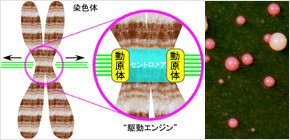
Clarification of mechanism behind stable neocentromere relocation in chromosomes
Clarified stable relocation of kinetochores in subtelomeric positions on a chromosome
Under the leadership of ISHII Koujirou (Visiting Associate Professor, Graduate School of Frontier Biosciences, Osaka University) a group of researchers demonstrated a process through which they were able to clarify stable relocation of kinetochores in subtelomeric positions on a chromosome. Kinetochores are a higher order cell structure involved in mitosis. The main function of kinetochores is to aid the division of chromosomes during mitosis. Kinetochores are located on centromeres, specialized chromosomal regions.
This group demonstrated that kinetochores could be relocated on chromosomal regions other than centromeres and that for such relocation to be successful, the level of histone H2A variant H2A.Z. needed to be lowered. This group's achievement is a great step in the understanding of chromosomal properties at the molecular level.
Abstract
In most eukaryotes, centromeres are epigenetically defined by nucleosomes that contain the histone H3 variant centromere protein A (CENP-A). Specific targeting of the CENP-A–loading chaperone to the centromere is vital for stable centromere propagation; however, the existence of ectopic centromeres (neocentromeres) indicates that this chaperone can function in different chromatin environments. The mechanism responsible for accommodating the CENP-A chaperone at noncentromeric regions is poorly understood. Here, we report the identification of transient, immature neocentromeres in Schizosaccharomyces pombe that show reduced association with the CENP-A chaperone Scm3, owing to persistence of the histone H2A variant H2A.Z. After the acquisition of adjacent heterochromatin or relocation of the immature neocentromeres to subtelomeric regions, H2A.Z was depleted and Scm3 was replenished, thus leading to subsequent stabilization of the neocentromeres. These findings provide new insights into histone variant–mediated epigenetic control of neocentromere establishment.

Figure 1

Figure 2

Figure 3
To learn more about this research, please read the full research report entitled " Epigenetically induced paucity of histone H2A.Z stabilizes fission yeast ectopic centromeres " at this page of the Nature Structural & Molecular Biology website.
Related link :
